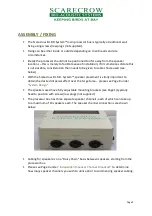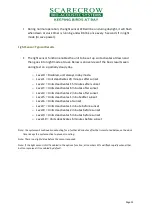
PRACTICAL TIPS (Cont.)
Coverage
•
Total coverage the system is able to provide is dependent on many factors, not least
of which is the number of speakers utilised. Under normal circumstances we would
not look to design a system where any speaker(s) are required to broadcast in excess
of 100m distance.
•
Other dependent factors would include the lie of the land, prevailing weather
conditions, strength/direction of wind, other ambient noise, air temperature,
shape/design of target area and obstructions to sound broadcast.
•
Taking this into account, it is important to remember that the broadcast needs to
sound at a natural level to the birds for greatest effect – too loud or too quiet, will
merely either sound like a noise to the target birds and be ignored, or not heard at
all.
Effect on other wildlife
•
The calls broadcast are only recognisable by the target bird species, and therefore
has no lasting effect on other wildlife at all.
•
That is not to say that there will be no reaction – in some extreme cases, the
broadcast of a distress call may for example bring in a Hawk hoping to find some
easy food.
Relocating the Scarecrow B.I.R.D. System
•
Under normal circumstances due to the cable runs with the Scarecrow B.I.R.D.
System™, once speakers are in place they are left where they are.
•
Whilst “speaker relocation” is an option, it is recommended that a system should
ideally remain in situ if an area is required to be kept free of birds; nevertheless,
speakers can be repositioned if required.
•
The concept of the system is to create the impression over time that the area is a
“threat area” and one therefore to avoid – so over time the bird numbers may even
reduce. This is achieved by the regular (but not too frequent) broadcast of the
Distress Call, which clearly cannot be achieved if the system is relocated to
alternative areas.
Variable Volume
•
The system incorporates a “variable volume” feature – during broadcast the volume
will automatically vary between the maximum set level, and approximately 20
metres from the unit.
•
This is to provide the perception of predator movement, to aid to the overall
confusion and concern of the target specie, to improve dispersal performance.
•
This feature also ensures that no matter where the target bird may be within the
overall coverage area during the time of broadcast, at some point the broadcast
sound level will certainly sound as if it is at a natural level.
Page 3





































